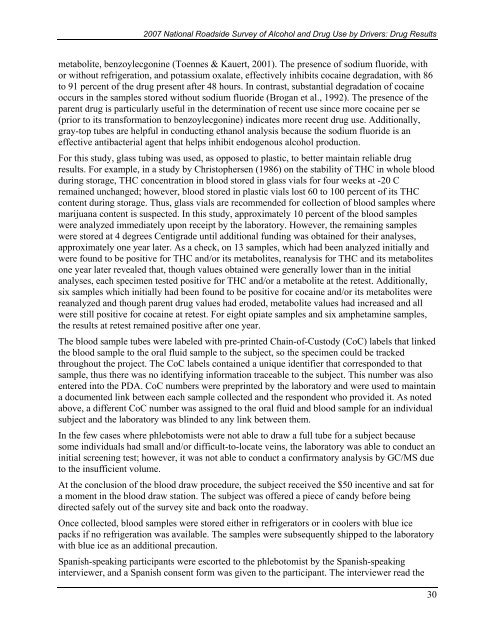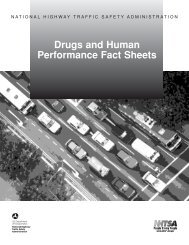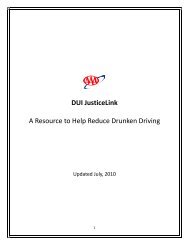2007 National Roadside Survey of Alcohol and Drug Use by Drivers
2007 National Roadside Survey of Alcohol and Drug Use by Drivers
2007 National Roadside Survey of Alcohol and Drug Use by Drivers
Create successful ePaper yourself
Turn your PDF publications into a flip-book with our unique Google optimized e-Paper software.
<strong>2007</strong> <strong>National</strong> <strong>Roadside</strong> <strong>Survey</strong> <strong>of</strong> <strong>Alcohol</strong> <strong>and</strong> <strong>Drug</strong> <strong>Use</strong> <strong>by</strong> <strong>Drivers</strong>: <strong>Drug</strong> Resultsmetabolite, benzoylecgonine (Toennes & Kauert, 2001). The presence <strong>of</strong> sodium fluoride, withor without refrigeration, <strong>and</strong> potassium oxalate, effectively inhibits cocaine degradation, with 86to 91 percent <strong>of</strong> the drug present after 48 hours. In contrast, substantial degradation <strong>of</strong> cocaineoccurs in the samples stored without sodium fluoride (Brogan et al., 1992). The presence <strong>of</strong> theparent drug is particularly useful in the determination <strong>of</strong> recent use since more cocaine per se(prior to its transformation to benzoylecgonine) indicates more recent drug use. Additionally,gray-top tubes are helpful in conducting ethanol analysis because the sodium fluoride is aneffective antibacterial agent that helps inhibit endogenous alcohol production.For this study, glass tubing was used, as opposed to plastic, to better maintain reliable drugresults. For example, in a study <strong>by</strong> Christophersen (1986) on the stability <strong>of</strong> THC in whole bloodduring storage, THC concentration in blood stored in glass vials for four weeks at -20 Cremained unchanged; however, blood stored in plastic vials lost 60 to 100 percent <strong>of</strong> its THCcontent during storage. Thus, glass vials are recommended for collection <strong>of</strong> blood samples wheremarijuana content is suspected. In this study, approximately 10 percent <strong>of</strong> the blood sampleswere analyzed immediately upon receipt <strong>by</strong> the laboratory. However, the remaining sampleswere stored at 4 degrees Centigrade until additional funding was obtained for their analyses,approximately one year later. As a check, on 13 samples, which had been analyzed initially <strong>and</strong>were found to be positive for THC <strong>and</strong>/or its metabolites, reanalysis for THC <strong>and</strong> its metabolitesone year later revealed that, though values obtained were generally lower than in the initialanalyses, each specimen tested positive for THC <strong>and</strong>/or a metabolite at the retest. Additionally,six samples which initially had been found to be positive for cocaine <strong>and</strong>/or its metabolites werereanalyzed <strong>and</strong> though parent drug values had eroded, metabolite values had increased <strong>and</strong> allwere still positive for cocaine at retest. For eight opiate samples <strong>and</strong> six amphetamine samples,the results at retest remained positive after one year.The blood sample tubes were labeled with pre-printed Chain-<strong>of</strong>-Custody (CoC) labels that linkedthe blood sample to the oral fluid sample to the subject, so the specimen could be trackedthroughout the project. The CoC labels contained a unique identifier that corresponded to thatsample, thus there was no identifying information traceable to the subject. This number was alsoentered into the PDA. CoC numbers were preprinted <strong>by</strong> the laboratory <strong>and</strong> were used to maintaina documented link between each sample collected <strong>and</strong> the respondent who provided it. As notedabove, a different CoC number was assigned to the oral fluid <strong>and</strong> blood sample for an individualsubject <strong>and</strong> the laboratory was blinded to any link between them.In the few cases where phlebotomists were not able to draw a full tube for a subject becausesome individuals had small <strong>and</strong>/or difficult-to-locate veins, the laboratory was able to conduct aninitial screening test; however, it was not able to conduct a confirmatory analysis <strong>by</strong> GC/MS dueto the insufficient volume.At the conclusion <strong>of</strong> the blood draw procedure, the subject received the $50 incentive <strong>and</strong> sat fora moment in the blood draw station. The subject was <strong>of</strong>fered a piece <strong>of</strong> c<strong>and</strong>y before beingdirected safely out <strong>of</strong> the survey site <strong>and</strong> back onto the roadway.Once collected, blood samples were stored either in refrigerators or in coolers with blue icepacks if no refrigeration was available. The samples were subsequently shipped to the laboratorywith blue ice as an additional precaution.Spanish-speaking participants were escorted to the phlebotomist <strong>by</strong> the Spanish-speakinginterviewer, <strong>and</strong> a Spanish consent form was given to the participant. The interviewer read the30




